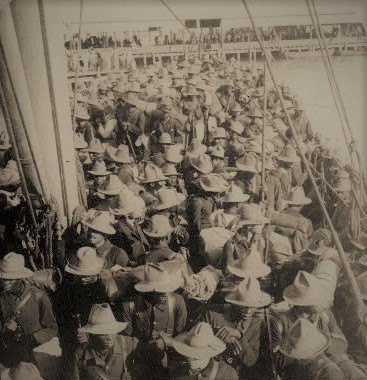


The 23rd Kansas
Volunteer Infantry served its term of service within the continental
United States and as part of the U.S. occupation forces in Cuba.
The Twenty-third Kansas Volunteer Infantry was mustered into the federal service at Camp Leedy in Topeka, Kansas between July 2 and July 19, 1898. At the time of mustering in, the regiment consisted of 29 officers and 850 enlisted men. The regiment, consisting entirely of men of color, was commanded by Colonel James Beck. The 23rd Kansas was unique in that Beck, like the remainder of the officers, was a man of color himself. This was atypical among the African American regiments that took part in the Spanish American War in that the others all had white officers. Also, most regiments of the period consisted of twelve companies, whereas the 23rd Kansas consisted of only eight companies, which is reflected in the lower number of officers and enlisted men at the time of mustering in.
From Jersey City, the regiment crossed via barge to Brooklyn where it boarded the transport VIGILANCIA for the journey to Cuba. While at the Brooklyn docks, the newspapers charged that the regiment, which had been without food for twelve hours, broke ranks and raided local fruit stands and restaurants in search of food. Only after obtaining food did the men agree to board the transport. Some sources claimed that this event never occurred and was invented by the press. Something apparently did occur, but the actual extent is unclear.
The regiment was being sent to Cuba because it was thought, incorrectly, that men of color and residents of the deep south would be more immune to the tropical diseases that had decimated Major General William Shafter’s Fifth Corps. The 23rd Kansas was one of a number of regiments termed “immunes” for this reason. This theory led to the deaths of many men who, as it turned out, were not actually immune to the diseases of the tropical Cuban climate. With the return of the Fifth Corps to the U.S., troops were needed to serve in the occupation forces in Cuba and "immunes" were preferred.
The VIGILANCIA encountered rough seas as it plodded toward Cuba, causing an outbreak of seasickness among the 23rd Kansas. The transport regiment arrived at Santiago, Cuba on August 31, passing the wrecks of the REINA MERCEDES and the MERRIMAC as it entered the harbor . Once in Cuba, the 23rd Kansas was ordered to the vicinity of San Luis which was a twenty-six mile train trip from Santiago. Here the regiment found itself in the company of the 8th Illinois Volunteer Infantry and the 9th Louisiana Volunteer Infantry, both also African American regiments (though commanded by white officers). These regiments performed various duties such as guarding the town against guerilla attacks and guarding about five thousand Spanish prisoners of war awaiting repatriation. While the regiment was in San Luis, the Treaty of Paris was signed on December 10, 1898, ending the Spanish American War.
On March 1, 1899 the regiment boarded the transport
MINNEWASKA for the return
trip to the United States and arrived at Newport News, Virginia four
days later. Many regiments, when they were to return home, were issued
new uniforms to replace those that faded and tattered through their
service so that the regiment could make a good appearance on its return.
The 23rd Kansas, however, was only issued new great coats
(overcoats) at Newport News to cover their worn uniforms. On March
10, the regiment departed Newport News for Leavenworth, Kansas, arriving
on March 10. Unfortunately, on the train while returning to Kansas a
fight broke out between William Williams of Company G and George Ray of
Company H. Williams was standing guard on one the of the
train car platforms. An argument broke out between Williams and George
Ray over the merits of their two companies. Williams apparently
was insulted in the exchange and knocked Ray down. In the ensuing
scuffle Ray stabbed Williams twice, killing him within minutes. Ray was
given a courtsmartial but was acquitted with it being decided that his
action was justifiable, apparently as it was done in self-defense.
Once at Leavenworth, the regiment was noted for its excellent deportment. Unlike most regiments, none of the men were arrested for any reason.
The 23rd Kansas was mustered out on April 10, 1899 at Fort Leavenworth. At the time of mustering out, the regiment consisted of 28 officers, and 823 enlisted men. During its term of service, the regiment lost one officer and eleven enlisted men to disease, one enlisted man died as the result of an accident and one enlisted man (Williams) died as the result of a homocide. The man killed in the accident was Alonzo Dayton of Company G who was killed on August 18, 1898 in a rail car accident.“A Letter from Cuba,” The Emporia Gazette (Emporia, Kansas). November 9, 1898, p. 1
Correspondence relating to the War with Spain And Conditions Growing Out of the Same Including the Insurrection in the Philippine Island and the China Relief Expedition. Vol. 1 (Washington: Government Printing Office, 1902).
"Kansas Troops from Cuba," Miltonvale Press
(Miltonvale, Kansas). March 16, 1899, p. 1.
“Last Retreat,” The Topeka Plaindealer (Topeka, Kansas). April 14, 1899, p. 2
Lovett, Christopher C., “To Serve Faithfully – The Twenty-third Kansas Volunteer Infantry and the Spanish American War,” Kansas History. https:www.kshs.org/publicat/history/1998winter_lovett.pdf
"The Twenty-Third Kansas," The Topeka Plaindealer (Topeka, Kansas). March 17, 1899, p. 3.
‘They Were Hungry,” Emporia Daily Republican (Emporia, Kansas). August 26, 1898. p. 4.
Untitled article on the regiment at Erie Station, The Lyon County News and The Emporia Times (Emporia, Kansas). September 9, 1898, p. 7.
Untitled
article on the acquittal of George Ray, Kansas City Chief (Troy,
Kansas). May 4, 1899, p. 7.